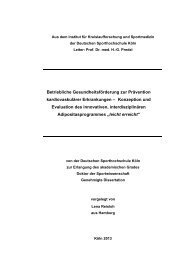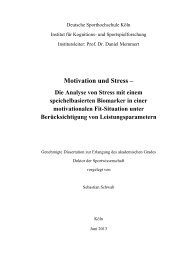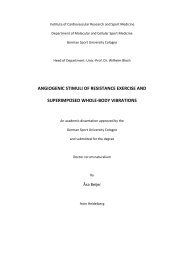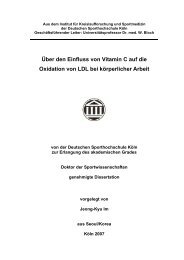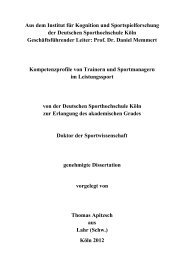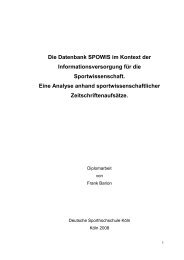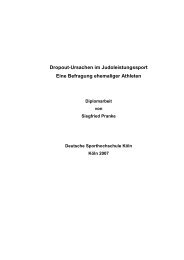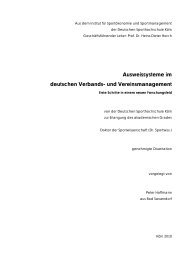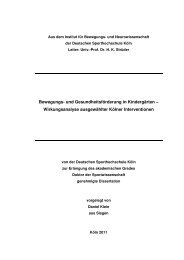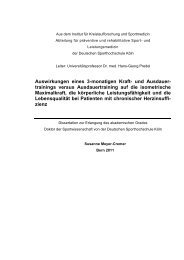- Seite 1 und 2: Aus dem Psychologischen Institut de
- Seite 3 und 4: Eidesstattliche Erklärung Hierdurc
- Seite 5 und 6: Vorwort Im Verlauf der Promotion bi
- Seite 7: Zusammenfassung / Summary Ermüdung
- Seite 11 und 12: Gliederung III 4.4.2 Methodisches V
- Seite 13 und 14: Tabellenverzeichnis V Tabellenverze
- Seite 15 und 16: Tabellenverzeichnis VII Tabelle 40:
- Seite 17 und 18: Abbildungsverzeichnis IX Abbildung
- Seite 19 und 20: Einleitung 1 Einleitung Ermüdung z
- Seite 21 und 22: Einleitung 3 allgemein werden von d
- Seite 23 und 24: Einleitung 5 Daneben liegt aber auc
- Seite 25 und 26: Darstellung wesentlicher Grundannah
- Seite 27 und 28: Darstellung wesentlicher Grundannah
- Seite 29 und 30: Darstellung wesentlicher Grundannah
- Seite 31 und 32: Theoretischer Bezugsrahmen: Risiko
- Seite 33 und 34: Theoretischer Bezugsrahmen: Risiko
- Seite 35 und 36: Theoretischer Bezugsrahmen: Risiko
- Seite 37 und 38: Theoretischer Bezugsrahmen: Risiko
- Seite 39 und 40: Theoretischer Bezugsrahmen: Risiko
- Seite 41 und 42: Theoretischer Bezugsrahmen: Risiko
- Seite 43 und 44: Theoretischer Bezugsrahmen: Risiko
- Seite 45 und 46: Theoretischer Bezugsrahmen: Risiko
- Seite 47 und 48: Theoretischer Bezugsrahmen: Risiko
- Seite 49 und 50: Theoretischer Bezugsrahmen: Risiko
- Seite 51 und 52: Theoretischer Bezugsrahmen: Risiko
- Seite 53 und 54: Theoretischer Bezugsrahmen: Risiko
- Seite 55 und 56: Theoretischer Bezugsrahmen: Risiko
- Seite 57 und 58: Theoretischer Bezugsrahmen: Risiko
- Seite 59 und 60:
Theoretischer Bezugsrahmen: Risiko
- Seite 61 und 62:
Theoretischer Bezugsrahmen: Risiko
- Seite 63 und 64:
Theoretischer Bezugsrahmen: Risiko
- Seite 65 und 66:
Theoretischer Bezugsrahmen: Risiko
- Seite 67 und 68:
Theoretischer Bezugsrahmen: Risiko
- Seite 69 und 70:
Theoretischer Bezugsrahmen: Risiko
- Seite 71 und 72:
Theoretischer Bezugsrahmen: Risiko
- Seite 73 und 74:
Theoretischer Bezugsrahmen: Risiko
- Seite 75 und 76:
Theoretischer Bezugsrahmen: Risiko
- Seite 77 und 78:
Theoretischer Bezugsrahmen: Risiko
- Seite 79 und 80:
Theoretischer Bezugsrahmen: Risiko
- Seite 81 und 82:
Theoretischer Bezugsrahmen: Risiko
- Seite 83 und 84:
Theoretischer Bezugsrahmen: Risiko
- Seite 85 und 86:
Zusammenfassung der Grundlagen als
- Seite 87 und 88:
Zusammenfassung der Grundlagen als
- Seite 89 und 90:
Zusammenfassung der Grundlagen als
- Seite 91 und 92:
Zusammenfassung der Grundlagen als
- Seite 93 und 94:
Zusammenfassung der Grundlagen als
- Seite 95 und 96:
Zusammenfassung der Grundlagen als
- Seite 97 und 98:
Entwicklung eines verhaltensnahen V
- Seite 99 und 100:
Entwicklung eines verhaltensnahen V
- Seite 101 und 102:
Entwicklung eines verhaltensnahen V
- Seite 103 und 104:
Entwicklung eines verhaltensnahen V
- Seite 105 und 106:
Entwicklung eines verhaltensnahen V
- Seite 107 und 108:
Entwicklung eines verhaltensnahen V
- Seite 109 und 110:
Entwicklung eines verhaltensnahen V
- Seite 111 und 112:
Entwicklung eines verhaltensnahen V
- Seite 113 und 114:
Entwicklung eines verhaltensnahen V
- Seite 115 und 116:
Entwicklung eines verhaltensnahen V
- Seite 117 und 118:
Entwicklung eines verhaltensnahen V
- Seite 119 und 120:
Entwicklung eines verhaltensnahen V
- Seite 121 und 122:
Entwicklung eines verhaltensnahen V
- Seite 123 und 124:
Entwicklung eines verhaltensnahen V
- Seite 125 und 126:
Entwicklung eines verhaltensnahen V
- Seite 127 und 128:
Entwicklung eines verhaltensnahen V
- Seite 129 und 130:
Entwicklung eines verhaltensnahen V
- Seite 131 und 132:
Entwicklung eines verhaltensnahen V
- Seite 133 und 134:
Entwicklung eines verhaltensnahen V
- Seite 135 und 136:
Entwicklung eines verhaltensnahen V
- Seite 137 und 138:
Entwicklung eines verhaltensnahen V
- Seite 139 und 140:
Entwicklung eines verhaltensnahen V
- Seite 141 und 142:
Entwicklung eines verhaltensnahen V
- Seite 143 und 144:
Entwicklung eines verhaltensnahen V
- Seite 145 und 146:
Entwicklung eines verhaltensnahen V
- Seite 147 und 148:
Entwicklung eines verhaltensnahen V
- Seite 149 und 150:
Entwicklung eines verhaltensnahen V
- Seite 151 und 152:
Entwicklung eines verhaltensnahen V
- Seite 153 und 154:
Entwicklung eines verhaltensnahen V
- Seite 155 und 156:
Entwicklung eines verhaltensnahen V
- Seite 157 und 158:
Entwicklung eines verhaltensnahen V
- Seite 159 und 160:
Entwicklung eines verhaltensnahen V
- Seite 161 und 162:
Entwicklung eines verhaltensnahen V
- Seite 163 und 164:
Entwicklung eines verhaltensnahen V
- Seite 165 und 166:
Entwicklung eines verhaltensnahen V
- Seite 167 und 168:
Entwicklung eines verhaltensnahen V
- Seite 169 und 170:
Entwicklung eines verhaltensnahen V
- Seite 171 und 172:
Entwicklung eines verhaltensnahen V
- Seite 173 und 174:
Entwicklung eines verhaltensnahen V
- Seite 175 und 176:
Entwicklung eines verhaltensnahen V
- Seite 177 und 178:
Entwicklung eines verhaltensnahen V
- Seite 179 und 180:
Entwicklung eines verhaltensnahen V
- Seite 181 und 182:
Entwicklung eines verhaltensnahen V
- Seite 183 und 184:
Untersuchung zur Beeinflussung von
- Seite 185 und 186:
Untersuchung zur Beeinflussung von
- Seite 187 und 188:
Untersuchung zur Beeinflussung von
- Seite 189 und 190:
Untersuchung zur Beeinflussung von
- Seite 191 und 192:
Untersuchung zur Beeinflussung von
- Seite 193 und 194:
Untersuchung zur Beeinflussung von
- Seite 195 und 196:
Untersuchung zur Beeinflussung von
- Seite 197 und 198:
Untersuchung zur Beeinflussung von
- Seite 199 und 200:
Untersuchung zur Beeinflussung von
- Seite 201 und 202:
Untersuchung zur Beeinflussung von
- Seite 203 und 204:
Untersuchung zur Beeinflussung von
- Seite 205 und 206:
Untersuchung zur Beeinflussung von
- Seite 207 und 208:
Untersuchung zur Beeinflussung von
- Seite 209 und 210:
Untersuchung zur Beeinflussung von
- Seite 211 und 212:
Untersuchung zur Beeinflussung von
- Seite 213 und 214:
Untersuchung zur Beeinflussung von
- Seite 215 und 216:
Untersuchung zur Beeinflussung von
- Seite 217 und 218:
Untersuchung zur Beeinflussung von
- Seite 219 und 220:
Untersuchung zur Beeinflussung von
- Seite 221 und 222:
Untersuchung zur Beeinflussung von
- Seite 223 und 224:
Untersuchung zur Beeinflussung von
- Seite 225 und 226:
Untersuchung zur Beeinflussung von
- Seite 227 und 228:
Untersuchung zur Beeinflussung von
- Seite 229 und 230:
Untersuchung zur Beeinflussung von
- Seite 231 und 232:
Untersuchung zur Beeinflussung von
- Seite 233 und 234:
Untersuchung zur Beeinflussung von
- Seite 235 und 236:
Untersuchung zur Beeinflussung von
- Seite 237 und 238:
Untersuchung zur Beeinflussung von
- Seite 239 und 240:
Untersuchung zum Einfluss stabiler
- Seite 241 und 242:
Untersuchung zum Einfluss stabiler
- Seite 243 und 244:
Untersuchung zum Einfluss stabiler
- Seite 245 und 246:
Untersuchung zum Einfluss stabiler
- Seite 247 und 248:
Untersuchung zum Einfluss stabiler
- Seite 249 und 250:
Untersuchung zum Einfluss stabiler
- Seite 251 und 252:
Untersuchung zum Einfluss stabiler
- Seite 253 und 254:
Untersuchung zum Einfluss stabiler
- Seite 255 und 256:
Untersuchung zum Einfluss stabiler
- Seite 257 und 258:
Untersuchung zum Einfluss stabiler
- Seite 259 und 260:
Untersuchung zum Einfluss stabiler
- Seite 261 und 262:
Untersuchung zum Einfluss stabiler
- Seite 263 und 264:
Untersuchung zum Einfluss stabiler
- Seite 265 und 266:
Untersuchung zum Einfluss stabiler
- Seite 267 und 268:
Untersuchung zum Einfluss stabiler
- Seite 269 und 270:
Untersuchung zum Einfluss stabiler
- Seite 271 und 272:
Zusammenfassende Bemerkungen: Disku
- Seite 273 und 274:
Zusammenfassende Bemerkungen: Disku
- Seite 275 und 276:
Zusammenfassende Bemerkungen: Disku
- Seite 277 und 278:
Zusammenfassende Bemerkungen: Disku
- Seite 279 und 280:
Zusammenfassende Bemerkungen: Disku
- Seite 281 und 282:
Zusammenfassende Bemerkungen: Disku
- Seite 283 und 284:
Zusammenfassende Bemerkungen: Disku
- Seite 285 und 286:
Zusammenfassende Bemerkungen: Disku
- Seite 287 und 288:
Literatur 269 Bachl, N. (1980). Unf
- Seite 289 und 290:
Literatur 271 Chmura, J. (1993). Ve
- Seite 291 und 292:
Literatur 273 Geiger, L.V. (1992).
- Seite 293 und 294:
Literatur 275 Hoppe, F. (1930). Unt
- Seite 295 und 296:
Literatur 277 Kleinert, J., Jüngli
- Seite 297 und 298:
Literatur 279 Martha, C., Sanchez,
- Seite 299 und 300:
Literatur 281 Renn, O. (1989). Risi
- Seite 301 und 302:
Literatur 283 Singer, R., Eberspäc
- Seite 303 und 304:
Literatur 285 Van der Linden, D., F
- Seite 305 und 306:
Anhang 287 Anhang Anhang A: Testfor
- Seite 307 und 308:
Anhang 289 A 1. Ergebnisformular Bl
- Seite 309 und 310:
Anhang 291 A. 3. Ergebnisformular z
- Seite 311 und 312:
Anhang 293 A 5. Datenerfassung RPE-
- Seite 313 und 314:
Anhang 295 B 1. Kolmogorov-Smirnov-
- Seite 315 und 316:
Anhang 297 B 2. Kolmogorov-Smirnov-
- Seite 317 und 318:
Anhang 299 B 3. Kolmogorov-Smirnov-
- Seite 319 und 320:
Anhang 301 B 4. Kolmogorov-Smirnov-
- Seite 321 und 322:
Anhang 303 C 1. Varianzanalyse des
- Seite 323 und 324:
Anhang 305 C 3. Varianzanalyse des
- Seite 325 und 326:
Anhang 307 Anhang D: Ergebnistabell
- Seite 327 und 328:
Anhang 309 D 2. Multiple Regression
- Seite 329 und 330:
Anhang 311 D 3. Multiple Regression
- Seite 331:
S A B I N E J Ü N G L I N G (Diplo




